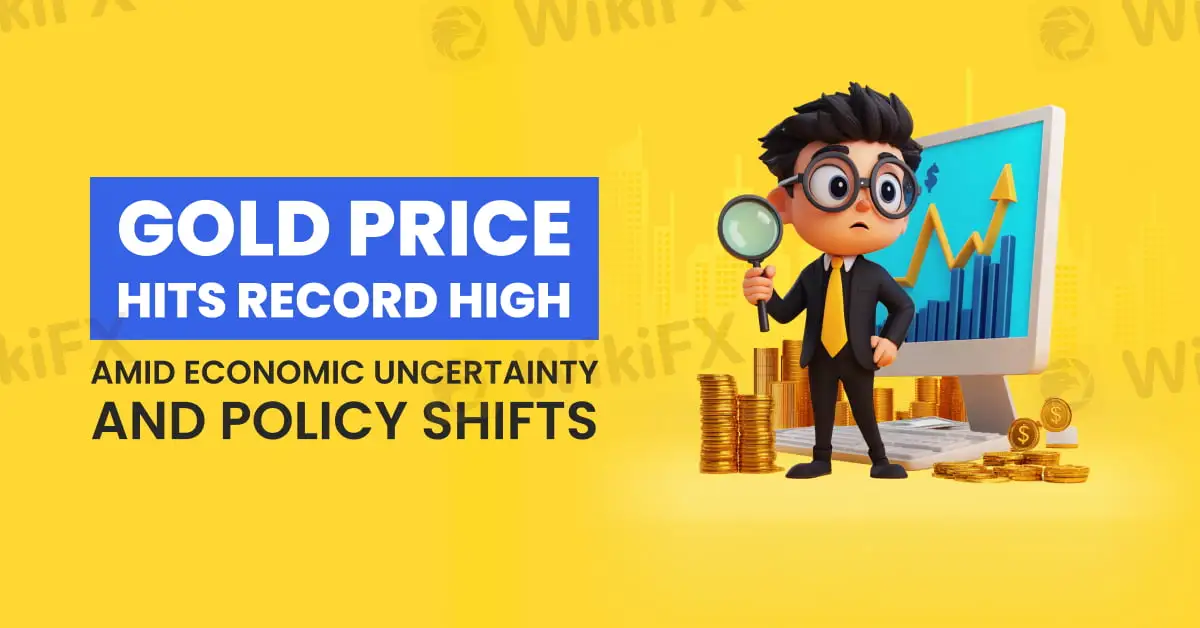简体中文
繁體中文
English
Pусский
日本語
ภาษาไทย
Tiếng Việt
Bahasa Indonesia
Español
हिन्दी
Filippiiniläinen
Français
Deutsch
Português
Türkçe
한국어
العربية
Gold Price Hits Record High Amid Economic Uncertainty and Policy Shifts
Abstract:Gold prices soared to an all-time high, nearing the key $3,000 per ounce threshold, as investors responded to heightened tariff uncertainty and growing expectations of monetary policy easing by the U.S. Federal Reserve.

Gold prices soared to an all-time high, nearing the key $3,000 per ounce threshold, as investors responded to heightened tariff uncertainty and growing expectations of monetary policy easing by the U.S. Federal Reserve. Spot gold reached approximately $2,994 per ounce, marking a historic peak driven by market anxieties and shifting economic policies.

Industry analysts anticipate further gains, with forecasts placing gold prices in the range of $3,000 to $3,200 per ounce over the course of the year. The ongoing global economic landscape, particularly the unpredictability of U.S. trade policies, has strengthened golds appeal as a safe-haven asset. The volatility surrounding trade negotiations and tariff adjustments has led investors to hedge their positions, favouring the precious metal in times of geopolitical and financial instability.
The Federal Reserves upcoming monetary policy meeting, scheduled for next Wednesday, remains a key focal point for markets. The central bank is widely expected to maintain its benchmark interest rate within the 4.25% to 4.50% range. However, policymakers face challenges in assessing the broader economic impact of ongoing trade disputes. Analysts suggest that the uncertainty surrounding tariff changes has made economic forecasting more complex, requiring the Fed to rely on evolving economic data to shape its next steps. The central bank has already reduced interest rates by 100 basis points since September but halted its easing cycle in January. Market expectations indicate a potential resumption of rate cuts as early as June.
Recent economic data has presented a mixed picture. The latest figures from the U.S. Labor Department revealed that producer prices remained unchanged in February, while the consumer price index recorded a 0.2% increase, following a more substantial 0.5% rise in January. These developments are being closely monitored by investors assessing inflation trends and the potential direction of monetary policy.
Beyond macroeconomic factors, strong demand from exchange-traded funds (ETFs) and continued central bank purchases have further propelled gold prices upward. Analysts highlight that, in addition to geopolitical tensions, the persistent uncertainty generated by shifting trade policies has reinforced investor appetite for the precious metal. As market conditions evolve, gold remains a key asset for those seeking stability amid financial turbulence.
With multiple forces at play, including global trade dynamics, Federal Reserve policy shifts, and inflationary pressures, golds trajectory remains a critical point of interest for investors worldwide. As prices approach the significant $3,000 milestone, market participants will continue to monitor economic indicators and central bank actions to gauge the future direction of the gold market.

Disclaimer:
The views in this article only represent the author's personal views, and do not constitute investment advice on this platform. This platform does not guarantee the accuracy, completeness and timeliness of the information in the article, and will not be liable for any loss caused by the use of or reliance on the information in the article.
Read more

Never Heard of Dynasty Trade? Here's Why You Should Be Worried
Have you heard this name before? No , it’s time you do because staying unaware could cost you. This platform is currently active in the forex trading and has been linked to several suspicious activities. Even if you’ve never dealt with it directly, there’s a chance it could reach out to you through ads, calls, messages, or social media. That’s why it’s important to know the red flags in advance.

Want to Deposit in the EVM Prime Platform? Stop Before You Lose It ALL
Contemplating forex investments in the EVM Prime platform? Think again! We empathize with those who have been bearing losses after losses with EVM Prime. We don't want you to be its next victim. Read this story that has investor complaints about EVM Prime.

WEEKLY SCAM BROKERS LIST IS OUT! Check it now
If you missed this week's fraud brokers list and are finding it difficult to track them one by one — don’t worry! We’ve brought together all the scam brokers you need to avoid, all in one place. Check this list now to stay alert and protect yourself from fraudulent brokers.

Catch the Latest Update on BotBro & Lavish Chaudhary
BotBro, an AI-based trading platform, became popular in India in 2024—but for negative reasons. Its founder, Lavish Chaudhary, who gained a huge following by promoting it heavily on social media. Since then, he has become well-known, but for many controversies. Let’s know the latest update about Botbro & Lavish Chaudhary.
WikiFX Broker
Latest News
WEEKLY SCAM BROKERS LIST IS OUT! Check it now
Apex Trader Funding is an Unregulated Firm | You Must Know the Risks
What WikiFX Found When It Looked Into Aron Markets
Textiles to whisky: U.K.–India 'historic' deal is set to boost bilateral trade by over $34 billion a year
Thailand-Cambodia border clashes: Cambodia's economy has more to lose, analysts say
Puma shares plunge 18% after full-year sales, profit outlook cut on U.S. tariffs
Is Your Forex Strategy Failing? Here’s When to Change
FSMA Warns That Some Firms Operate as Pyramid Schemes
Federal Reserve likely to hold interest rates steady despite pressure from Trump. Here's what that means for your money
Sigma-One Capital Scam? Investors Say They Can’t Withdraw Funds
Currency Calculator


